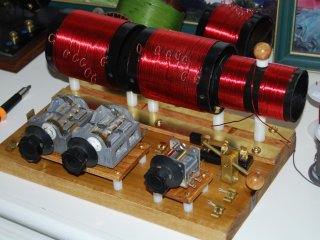
My second homemade, A double-tuned open test bed
Having learned my lesson with the Mystery set, I have set myself to make a double-tuned rig with open wireing for testing multiple configurations. The concept is to seek the maximum amount of flexibility in hookup and coil design. This will mean interchangeable coils with or without taps, and wireing with allegator clips. I have chosen to hard place in the set three capacitors, 2 double gang 20 - 460 pF and one 20 - 410 single unit. The detector, as always, will switch between a diode and my own crystal stand. The modular design will allow testing coils mainly although vcaps will also easily be tested with jumpers. The number of leads and allegator clips, not all used with any one configuration will give this a bit messy look, but this is not a beauty contest but for learning. As always I include the option of using either a germanium diode or actual crystal.
The photos and circuits below show two hookups currently completed.
Double tuned circuit with tapped coils and an optional QRM trap (unused in photo). This configuration alone will keep me busy quite a while! I am learning what "sharp" tuning is. The antenna coil is tunes series-parallel but the first, (left) 2-gang vcap while I only use one gang of the second vcap. For lower inductance coils I can use the second gang in parallel.
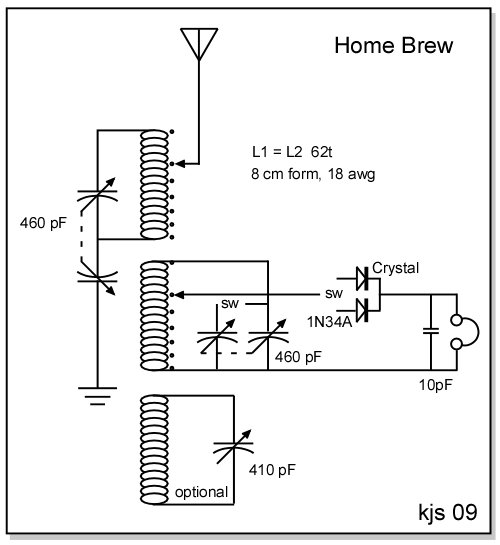

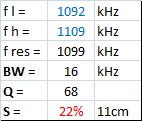
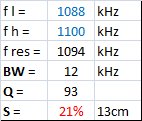
 Here I show the performance summary for my set with three coil separations, 11cm, 13cm and 18cm. With these charts you see the value and trade-offs in loose coupling between the antenna and detector circuits. With the coils at 11cm separation they are slightly over-coupled but still with relatively good Q, 68, and fair sensitivity at 22%. Separating the coils to 13cm and then to 18cm loosens the coupling allowing narrower bandwidths and higher Q (getting to 125, woohoo!), but at the sacrifice of much sensivitity, down to 15%, still reasonable. This is an excellent performance, I must be doing something right somewhere. Of course this is still a general listener radio and far far from the performance achievable in high-quality DX designs. But it is teaching me as intended.
Here I show the performance summary for my set with three coil separations, 11cm, 13cm and 18cm. With these charts you see the value and trade-offs in loose coupling between the antenna and detector circuits. With the coils at 11cm separation they are slightly over-coupled but still with relatively good Q, 68, and fair sensitivity at 22%. Separating the coils to 13cm and then to 18cm loosens the coupling allowing narrower bandwidths and higher Q (getting to 125, woohoo!), but at the sacrifice of much sensivitity, down to 15%, still reasonable. This is an excellent performance, I must be doing something right somewhere. Of course this is still a general listener radio and far far from the performance achievable in high-quality DX designs. But it is teaching me as intended.

Inspired by Dan Petersen's Galenatron, I wished to play with a vario-coupler design. This hookup uses a single form with an antenna coupling coil of 10 turns and a tapped secondary coil with 62 turns. The first 2-gang vcap is unused. The single-gang variable cap tunes the rotor. So far the best position seems to be keeping the rotor in-line with the main coil. More learning to come.
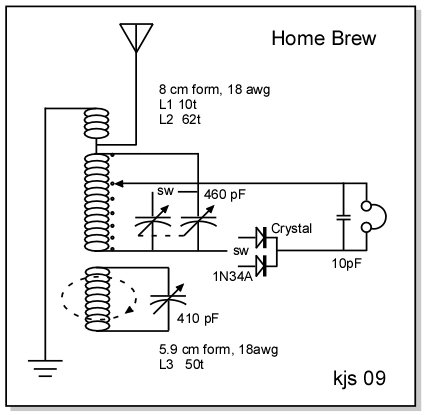

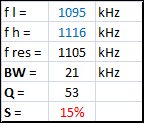 My homebrew in its Galenatron configuration shows fair Q at 53 and poor-fair sensitivity of 15%. There is a 1cm separation between the antenna coil and detector coil which may help. In many radios of this design I see the coils separated by 2-3mm only. As I wound the coils on a single form, there is no experimenting here, just wondering. The variocoupler here is only a trap and was not used in this measurement. With the return to a single-tuned set you need expect performance downgrade, but greater ease of use for general listening. I feel this configuration is a good compromise for easy listening without the hassel fo manipulating two (or more) tuning dials. It is clearly superior to the Dunwoody and De Forest single-tuned sets.
My homebrew in its Galenatron configuration shows fair Q at 53 and poor-fair sensitivity of 15%. There is a 1cm separation between the antenna coil and detector coil which may help. In many radios of this design I see the coils separated by 2-3mm only. As I wound the coils on a single form, there is no experimenting here, just wondering. The variocoupler here is only a trap and was not used in this measurement. With the return to a single-tuned set you need expect performance downgrade, but greater ease of use for general listening. I feel this configuration is a good compromise for easy listening without the hassel fo manipulating two (or more) tuning dials. It is clearly superior to the Dunwoody and De Forest single-tuned sets.

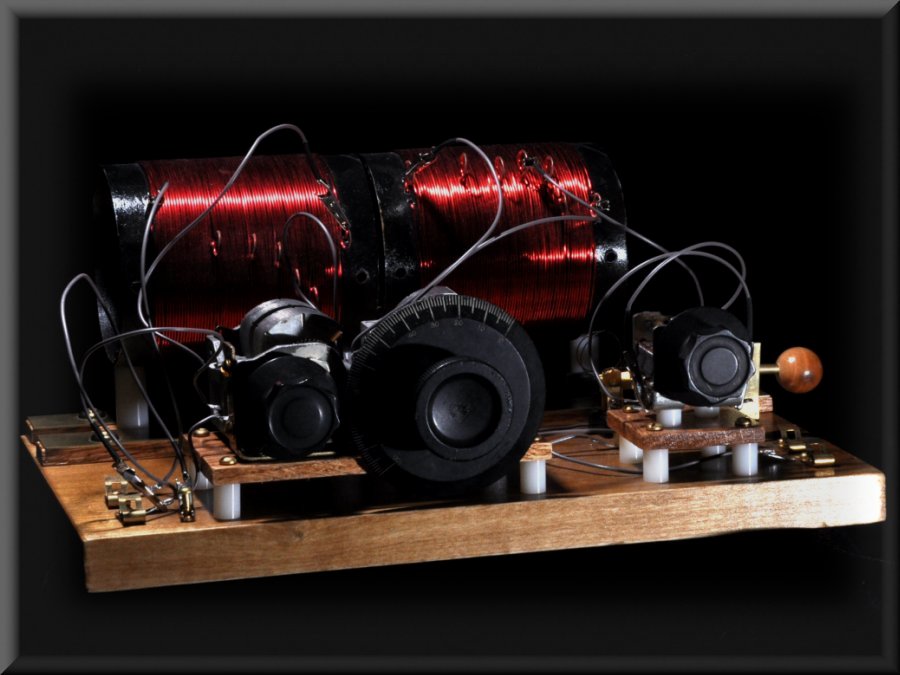





 Here I show the performance summary for my set with three coil separations, 11cm, 13cm and 18cm. With these charts you see the value and trade-offs in loose coupling between the antenna and detector circuits. With the coils at 11cm separation they are slightly over-coupled but still with relatively good Q, 68, and fair sensitivity at 22%. Separating the coils to 13cm and then to 18cm loosens the coupling allowing narrower bandwidths and higher Q (getting to 125, woohoo!), but at the sacrifice of much sensivitity, down to 15%, still reasonable. This is an excellent performance, I must be doing something right somewhere. Of course this is still a general listener radio and far far from the performance achievable in high-quality DX designs. But it is teaching me as intended.
Here I show the performance summary for my set with three coil separations, 11cm, 13cm and 18cm. With these charts you see the value and trade-offs in loose coupling between the antenna and detector circuits. With the coils at 11cm separation they are slightly over-coupled but still with relatively good Q, 68, and fair sensitivity at 22%. Separating the coils to 13cm and then to 18cm loosens the coupling allowing narrower bandwidths and higher Q (getting to 125, woohoo!), but at the sacrifice of much sensivitity, down to 15%, still reasonable. This is an excellent performance, I must be doing something right somewhere. Of course this is still a general listener radio and far far from the performance achievable in high-quality DX designs. But it is teaching me as intended.


 My homebrew in its Galenatron configuration shows fair Q at 53 and poor-fair sensitivity of 15%. There is a 1cm separation between the antenna coil and detector coil which may help. In many radios of this design I see the coils separated by 2-3mm only. As I wound the coils on a single form, there is no experimenting here, just wondering. The variocoupler here is only a trap and was not used in this measurement. With the return to a single-tuned set you need expect performance downgrade, but greater ease of use for general listening. I feel this configuration is a good compromise for easy listening without the hassel fo manipulating two (or more) tuning dials. It is clearly superior to the Dunwoody and De Forest single-tuned sets.
My homebrew in its Galenatron configuration shows fair Q at 53 and poor-fair sensitivity of 15%. There is a 1cm separation between the antenna coil and detector coil which may help. In many radios of this design I see the coils separated by 2-3mm only. As I wound the coils on a single form, there is no experimenting here, just wondering. The variocoupler here is only a trap and was not used in this measurement. With the return to a single-tuned set you need expect performance downgrade, but greater ease of use for general listening. I feel this configuration is a good compromise for easy listening without the hassel fo manipulating two (or more) tuning dials. It is clearly superior to the Dunwoody and De Forest single-tuned sets. 